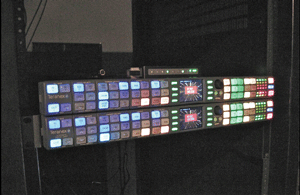Possible Trumps Perfect at the VMAs in 3D

Rihanna performs at the 2012 VMAs, Sept. 6 at the Staples Center.
LOS ANGELES—Few people saw the 3D broadcast of the MTV Video Music Awards on Sept. 6 from the Staples Center in Los Angeles. In fact the experience was limited to the hundreds of screaming fans in the neighboring L.A. Live Theater where Trojan Condoms had invited winners of an online lottery to view the show as an “enhanced experience” in 3D.
But the success of this Video Music Awards (VMA) presentation may provide a pathway out of the chicken-and-egg conundrum of not having enough 3D content to drive audience acceptance that is plaguing attempts to fill 24/7 3DTV programming schedules. The 2012 VMAs demonstrated that the capability of live 2D-to-3D conversion has risen to the extent that, although not perfect, is now highly possible and can produce a presentation that would be satisfactory for many production applications.
POSITIVE PARALLAX
To put this landmark experience on the 3D screen, the original 1080i/60 HD production from the Staples Center was given extra dimension by simultaneous, unassisted, 2D-to-3D conversion through a Blackmagic Design Teranex signal processor.
What the “Trojan Charged Intensified VMA Viewing Party” audience saw on the 3D screen, although admittedly not the cinema-quality 3D of “Avatar,” was thoroughly enjoyable. That’s partially thanks to the fact the Teranex processor created most of the 3D in positive parallax, or receding into the screen, thereby avoiding many of the stereographic taboos of hyperconvergence, edge violations, keystoning or alignment errors.
Additionally, since the 2D-to-3D conversion was from a single HD stream, there were no sync/genlock conflicts or risks of full reverse stereo imagery that has plagued other similar attempts. Only when the show’s host, Kevin Hart, was introducing the opening acts did a minor anomaly appear. MTV’s iconic Moonman figure had been projected on the screen at the rear of the stage in the Staples Center behind Hart but when seen in 3D in the L.A. Live theater it seemed to hover somewhere in the air above him. Still, this was the first time this technology had been given a public airing in the United States and, hey, it’s only rock and roll.
Blackmagic Design’s Teranex VC100 signal processor had been previously used by the Tennis Channel to convert the French Open into 3D on Memorial Day weekend, and both France’s Digital Factory (DF) and Germany’s Zweites Deutsches Fernsehen (ZDF) have been employing Teranex systems to convert archival 2D material. But the 2012 VMA’s marked its debut in the states.
The professional video industry's #1 source for news, trends and product and tech information. Sign up below.
Jeff Jacobs, senior vice president and executive in charge of production for the MTV Music Group, was in charge of most of the behind-the-scenes content production and distribution during the whole VMA Week, most prominently including producing the 3D screening in the L. A. Live theater.

The VMAs were shown in 3D at the “Trojan Charged Intesified VMA Viewing Party held at the neighboring L.A. Live Theater. “The 2D-to-3D conversion of the production that was seen at the Streaming Party in the L. A. Live theater was completely non-obtrusive to the main show,” Jacobs said. “Not one thing creative was changed and not a single camera was re-positioned. Nothing of the 3D screening impacted the main show what so ever to created the 2Dto- 3D conversion. That’s the magic of the Teranex technology.”
Positioning computer generated graphics in Z-space can be one of the trickiest aspects of 3D production. Most stereographers feel they should not draw attention to themselves by popping out of the screen or become obscured by competing with objects in the background. During the MTV Video Music Awards, all the billboards and lower thirds appeared right on the plane of the screen as they ideally should.
“We had the option of taking a clean feed [no graphics] from the production control room and inserting our own 3D graphics,” Jacobs explained. “But after seeing how good the graphics looked after the Teranex 2D-to-3D conversion we decided to go with the dirty feed (graphics included) and let the system position the graphics based on its own algorithms.”
One of the Teranex VC100 processors was used for the 2D-to-3D conversion, while another was employed to record 3D on a Sony SRW5800 videotape recorder for MTV’s archives. NEW TERANEX 3D PROCESSOR TO COME
What is the magic inside this box? As Blackmagic Design’s general manager of Teranex systems, Ray Conkling, explained, “Our Teranex 3D processor incorporates advanced Teranex proprietary technology, which includes two powerful video processing engines. Each engine has a Single Instruction, Multiple Data (SIMD) processing array that enables operations to occur on thousands of pixels simultaneously, along with a dedicated image warping processor that allows for complex image manipulation. This design combination of brute force SIMD processing and complex image warping and image processing algorithms, gives us the ability to create a number of applications.”

Although the Teranex VC100 signal processors have been capable of 2D-to-3D for a couple of years, the specific algorithms used for the VMA production will be incorporated into Blackmagic Design’s new Teranex 3D Processor system to be released later this year.
So the impact of this 2D-to-3D conversion demonstration could open new horizons for 3DTV delivery as long as the idealized perfect does not become the enemy of what is currently possible in 3D presentations. Broadcasters can factor in that conversion to 3D does not affect the original master, so improved dimensionalizing processes can always be applied later when they become available.
“If more audiences fall in love with the 3D experience, more viewers will demand it from their entertainment providers,” Jacobs predicted. “We are still at the ‘show and tell’ stage of 3D home entertainment. The more viewers who can experience it will determine how the broadcast industry embraces it.”
